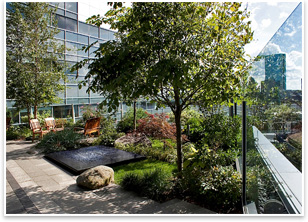Massachusetts Requires Hospitals to Employ Sustainable Design
by Tracy Ostroff
Contributing Editor
 How do you . . . green health-care facilities? How do you . . . green health-care facilities?
Summary: The Massachusetts Department of Public Health issued new environmental guidelines that went into effect January 1, requiring health-related institutions to use the Green Guide for Health Care™ (GGHC) or its equivalent in the design, construction, and renovation of facilities seeking the commonwealth’s Determination of Need approval. The new rules, approved last fall, are the first of their kind in the country.
Effective January 1, for hospitals, and July 1, 2009, for extended-care facilities, applicants will submit a provisional green and healthy strategy credit point assessment in their initial Department of Need application, then a completed certifiable assessment as part of their plan review. Final approval will be contingent on their getting at least 50 percent of the possible points in the Green Guide for Health Care or the USGBC’s prospective LEED®-HC silver rating.
Healthy hospitals, healthy communities
The new rules, proponents say, will emphasize non-toxic materials, more efficient and renewable energy systems, better air quality, and daylighting. Organizers note that while health-care facilities are complicated systems to which to apply standards, the guidelines will help achieve healthier hospitals—healthier for patients, healthier for staff, healthier for the environment and community, and
healthier for the hospital’s bottom line.
Early on in the implementation process, advocates identified the benefits of greening hospitals, including environmental stewardship to avoid harming public health while healing individuals, higher performance to enhance patient outcomes and staff performance, and better business practices to provide long-term resource/operational savings, better capital infusion, and better systems reliability and quality. The new regulations are built on a continuation of effort that has culminated in over a decade’s worth of relationship-building and collective work.
In the press release announcing the regulations, John Auerbach, Massachusetts Department of Public Health Commission, notes that the regulations promote public health and safety. “With this action, the department is adding a new layer of protection for the health of our citizens and establishes the importance of improving patient healing and staff wellness through environmentally sound building, construction, and operation of health-care facilities.”
 Leveling the playing field Leveling the playing field
The new rules are part of an effort to “level the playing field” and make a uniform standard across the state, says Paul Lipke, senior advisor, Energy and Buildings for Health Care Without Harm, an international coalition of hundreds of organizations that work to transform the health-care, including advocating for ecologically sustainable design. The group had worked with the City of Boston in 2007, to help enact green regulations for construction of its health-care facilities. Lipke applauds the state health department for embracing the standards. The agency’s Department of Determination of Need Director Joan Gorga says she is working to educate owners about incorporating sustainable strategies early on in the process.
Gorga says consultants have told her office that the new guidelines are helping to promote cost savings, decrease staff turnover, and create healthier environments for employees and patients. She highlights, as an example, materials that contribute to safer walking conditions in corridors, and harnessing more daylight for patient care and well-being. She says that officials from the unit of environmental health who focus on so-called “sick buildings” helped inform the use of certain areas of the guidelines, ensuring that material re-use, as called for in some of the sustainability matrices, do not promote mold and are appropriate for use in the health-care setting.
“It is helpful to have a designated standard to use to ensure that hospitals are utilizing the best resources available to them,” says Arthur Mombourquette, vice president for support services at Boston’s Brigham and Women’s Hospital, which is awaiting word, Gorga says, on whether its new state-of-the-art cardiovascular facility designed by Chan Krieger & Associates and Cannon Design, will receive the highest LEED certification. Lipke also notes that requirements provide clear performance benchmarks that can be reasonably achieved, making it easier for facilities and designers to set reachable targets.
Gorga notes that the owners applying to her office must have a plan of how they will achieve the 50-percent point benchmark. Once the blueprints go to the planning department, however, they must have their final checklist in hand for a point review. She advises owners and design teams not to cut it too close in the initial review by her office, because the final plans may call for strategies that conflict with other green strategies. Applicants need not apply for formal certification from the ratings groups; they only need certify they have achieved the goals they set forth in their blueprints.
Greening beyond hospitals
“The field is starting to build children's hospitals without asthma triggers and cancer centers without carcinogens. This is harder to achieve than you would think, but we know from many successes that requiring half the possible points is an aggressive but eminently do-able approval threshold,” Lipke says.
Lipke says other fields can take cues from the health-care sector to be better environmental stewards. He sees design professionals as a key link to employing sustainable strategies and taking businesses and government through an ecological culture shift to more broadly adopt health-based design principles in other building sectors.
“It’s certainly helpful that the regulatory authority has adopted this,” says Deborah Rivers, AIA, a senior associate at Perkins + Will in Boston. “It is easier for us as a design team. People realize they have to do this.” Rivers says she looks forward to the day when capital budgets merge expenditures and operations costs so large organizations like hospitals and other health-care facilities can allocate funds toward sustainable strategies that may have higher up-front costs but ample returns on investment.
|


 How do you . . .
How do you . . .  Leveling the playing field
Leveling the playing field